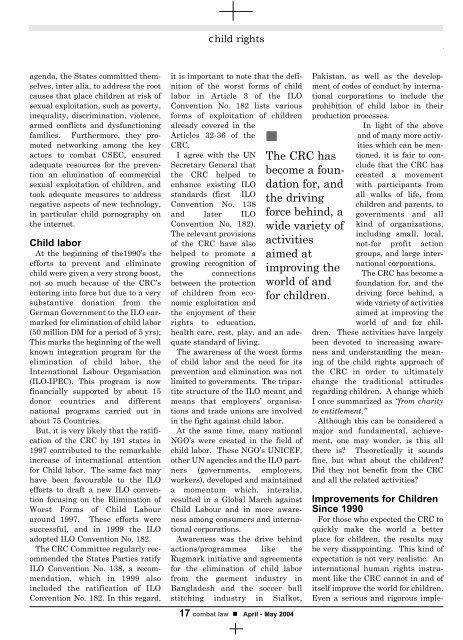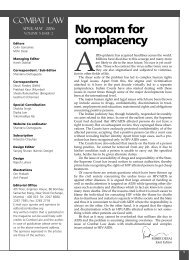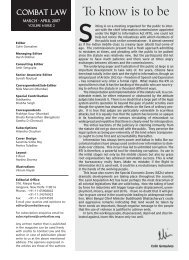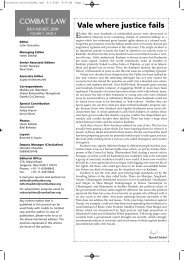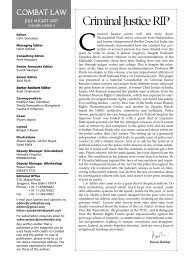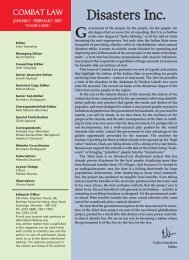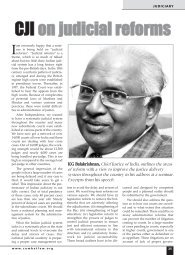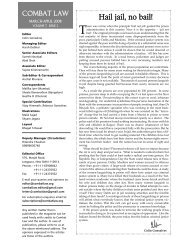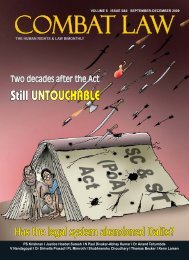PDF, 1.1MB - Combat Law
PDF, 1.1MB - Combat Law
PDF, 1.1MB - Combat Law
You also want an ePaper? Increase the reach of your titles
YUMPU automatically turns print PDFs into web optimized ePapers that Google loves.
child rightsagenda, the States committed themselves,inter alia, to address the rootcauses that place children at risk ofsexual exploitation, such as poverty,inequality, discrimination, violence,armed conflicts and dysfunctioningfamilies. Furthermore, they promotednetworking among the keyactors to combat CSEC, ensuredadequate resources for the preventionan elimination of commercialsexual exploitation of children, andtook adequate measures to addressnegative aspects of new technology,in particular child pornography onthe internet.Child laborAt the beginning of the1990’s theefforts to prevent and eliminatechild were given a very strong boost,not so much because of the CRC’sentering into force but due to a verysubstantive donation from theGerman Government to the ILO earmarkedfor elimination of child labor(50 million DM for a period of 5 yrs);This marks the beginning of the wellknown integration program for theelimination of child labor, theInternational Labour Organisation(ILO-IPEC). This program is nowfinancially supported by about 15donor countries and differentnational programs carried out inabout 75 Countries.But, it is very likely that the ratificationof the CRC by 191 states in1997 contributed to the remarkableincrease of international attentionfor Child labor. The same fact mayhave been favourable to the ILOefforts to draft a new ILO conventionfocusing on the Elimination ofWorst Forms of Child Labouraround 1997. These efforts weresuccessful, and in 1999 the ILOadopted ILO Convention No. 182.The CRC Committee regularly recommendedthe States Parties ratifyILO Convention No. 138, a recommendation,which in 1999 alsoincluded the ratification of ILOConvention No. 182. In this regard,it is important to note that the definitionof the worst forms of childlabor in Article 3 of the ILOConvention No. 182 lists variousforms of exploitation of childrenalready covered in theArticles 32-36 of theCRC.I agree with the UNSecretary General thatthe CRC helped toenhance existing ILOstandards (first ILOConvention No. 138and later ILOConvention No. 182).The relevant provisionsof the CRC have alsohelped to promote agrowing recognition ofthe connectionsbetween the protectionof children from economicexploitation andthe enjoyment of theirrights to education,health care, rest, play, and an adequatestandard of living.The awareness of the worst formsof child labor and the need for itsprevention and elimination was notlimited to governments. The tripartitestructure of the ILO meant andmeans that employers’ organisationsand trade unions are involvedin the fight against child labor.At the same time, many nationalNGO’s were created in the field ofchild labor. These NGO’s UNICEF,other UN agencies and the ILO partners(governments, employers,workers), developed and maintaineda momentum which, interalia,resulted in a Global March againstChild Labour and in more awarenessamong consumers and internationalcorporations.Awareness was the drive behindactions/programmes like theRugmark initiative and agreementsfor the elimination of child laborfrom the garment industry inBangladesh and the soccer ballstitching industry in Sialkot,The CRC hasbecome a foundationfor, andthe drivingforce behind, awide variety ofactivitiesaimed atimproving theworld of andfor children.Pakistan, as well as the developmentof codes of conduct by internationalcorporations to include theprohibition of child labor in theirproduction processes.In light of the aboveand of many more activitieswhich can be mentioned,it is fair to concludethat the CRC hascreated a movementwith participants fromall walks of life, fromchildren and parents, togovernments and allkind of organizations,including small, local,not-for profit actiongroups, and large internationalcorporations.The CRC has become afoundation for, and thedriving force behind, awide variety of activitiesaimed at improving theworld of and for children.These activities have largelybeen devoted to increasing awarenessand understanding the meaningof the child rights approach ofthe CRC in order to ultimatelychange the traditional attitudesregarding children. A change whichI once summarized as “from charityto entitlement.”Although this can be considered amajor and fundamental, achievement,one may wonder, is this allthere is? Theoretically it soundsfine, but what about the children?Did they not benefit from the CRCand all the related activities?Improvements for ChildrenSince 1990For those who expected the CRC toquickly make the world a betterplace for children, the results maybe very disappointing. This kind ofexpectation is not very realistic. Aninternational human rights instrumentlike the CRC cannot in and ofitself improve the world for children.Even a serious and rigorous imple-17 combat law • April - May 2004


